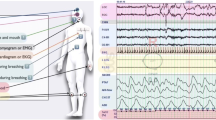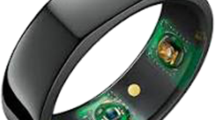Abstract
Wrist actigraphy is commonly used to measure sleep, and hip actigraphy is commonly used to measure activity. It is unclear whether hip-based actigraphy can be used to measure sleep. This study assessed the validity of wrist actigraphy and hip actigraphy compared to polysomnography (PSG) for the measurement of sleep. 108 healthy young adults (22.7 ± 0.2 years) wore hip and wrist GTX3+ Actigraph during overnight PSG. Measurements of total sleep time (TST), sleep efficiency (SE), sleep onset latency (SOL) and wake after sleep onset (WASO) were derived and compared between wrist actigraphy, hip actigraphy and PSG. Sensitivity, specificity and accuracy of wrist actigraphy and hip actigraphy for each variable were derived from epoch-by-epoch comparison to PSG. Compared to PSG: TST and SE were similar by wrist actigraphy but overestimated by hip actigraphy (both by 14%); SOL was underestimated by wrist actigraphy and hip actigraphy (by 39 and 80%, respectively); WASO was overestimated by wrist actigraphy and underestimated by hip actigraphy (by 34 and 65%, respectively). Compared to PSG the sensitivity, specificity and accuracy of wrist actigraphy were 90, 46 and 84%, respectively; and of hip actigraphy were 99, 14 and 86%, respectively. This study showed that using existing algorithms, a GTX3+ Actigraph worn on the hip does not provide valid or accurate measures of sleep, mainly due to poor wake detection. Relative to the hip, a wrist worn GTX3+ Actigraph provided more valid measures of sleep, but with only moderate capability to detect periods of wake during the sleep period.
Similar content being viewed by others
References
Mathie MJ, Coster AC, Lovell NH, Celler BG. Accelerometry: providing an integrated, practical method for long-term, ambulatory monitoring of human movement. Physiol. Meas. 2004; 25: R1–20.
Tryon WW. Nocturnal activity and sleep assessment. Clin. Psychol. Rev. 1996; 16: 197–213.
Adkins KW, Goldman SE, Fawkes D et al. A pilot study of shoulder placement for actigraphy in children. Behav. Sleep Med. 2012; 10: 138–47.
Middelkoop HA, van Dam EM, Smilde-van den Doel DA, Van Dijk G. 45-hour continuous quintuple-site actimetry: relations between trunk and limb movements and effects of circadian sleep-wake rhythmicity. Psychophysiology 1997; 34: 199–203.
Paavonen EJ, Fjälberg M, Steenari M-R, Aronen ET. Actigraphy placement and sleep estimation in children. Sleep 2002; 25: 235–7.
Enomoto M, Endo T, Suenaga K et al. Newly developed waist actigraphy and its sleep/wake scoring algorithm. Sleep Biol. Rhythms 2009; 7: 17–22.
Zinkhan M, Berger K, Hense S et al. Agreement of different methods for assessing sleep characteristics: a comparison of two actigraphs, wrist and hip placement, and self-report with polysomnography. Sleep Med. 2014; 15: 1107–14.
Morgenthaler TI, Lee-Chiong T, Alessi C et al. Practice parameters for the clinical evaluation and treatment of circadian rhythm sleep disorders. An American Academy of Sleep Medicine report. Sleep 2007; 30: 1445–59.
Troiano RP, Berrigan D, Dodd KW, Masse LC, Tilert T, McDowell M. Physical activity in the United States measured by accelerometer. Med. Sci. Sports Exerc. 2008; 40: 181–8.
Colley RC, Garriguet D, Janssen I, Craig CL, Clarke J, Tremblay MS. Physical activity of Canadian adults: accel-erometer results from the 2007 to 2009 Canadian Health Measures Survey. Health Rep. 2011; 22 (1): 7–14.
Kinder JR, Lee KA, Thompson H, Hicks K, Topp K, Madsen KA. Validation of a hip-worn accelerometer in measuring sleep time in children. J. Pediatr. Nurs. 2012; 27: 127–33.
Hjorth MF, Chaput JP, Damsgaard CT et al. Measure of sleep and physical activity by a single accelero-meter: can a waist-worn Actigraph adequately measure sleep in children? Sleep Biol. Rhythms 2012; 10: 328–35.
McKnight CM, Newnham JP, Stanley FJ et al. Birth of a cohort-the first 20 years of the Raine study. Med. J. Aust. 2012; 197: 608–10.
Berry RB, Brooks R, Gamaldo CE et al. The AASM Manual for the Scoring of Sleep and Associated Events. American Academy of Sleep Medicine: Darien, IL, 2012.
Sadeh A, Sharkey KM, Carskadon MA. Activity-based sleep-wake identification: an empirical test of methodological issues. Sleep 1994; 17: 201–7.
Bland JM, Altman DG. Statistical methods for assessing agreement between two methods of clinical measurement. Lancet 1986; 1 (8476): 307–10.
Bland JM, Altman DG. Comparing methods of measurement: why plotting difference against standard method is misleading. Lancet 1995; 346 (8982): 1085–7.
Ancoli-Israel S, Cole R, Alessi C, Chambers M, Moorcroft W, Pollak CP. The role of actigraphy in the study of sleep and circadian rhythms. Sleep 2003; 26: 342–92.
Tryon WW. Issues of validity in actigraphic sleep assessment. Sleep 2004; 27: 158–65.
Sadeh A. The role and validity of actigraphy in sleep medicine: an update. Sleep Med. Rev. 2011; 15: 259–67.
Blood ML, Sack RL, Percy DC, Pen JC. A comparison of sleep detection by wrist actigraphy, behavioral response, and polysomnography. Sleep 1997; 20: 388–95.
Marino M, Li Y, Rueschman MN et al. Measuring sleep: accuracy, sensitivity, and specificity of wrist actigraphy compared to polysomnography. Sleep 2013; 36: 1747–55.
Sadeh A, Acebo C. The role of actigraphy in sleep medicine. Sleep Med. Rev. 2002; 6: 113–24.
Moser D, Anderer P, Gruber G et al. Sleep classification according to AASM and Rechtschaffen & Kales: effects on sleep scoring parameters. Sleep 2009; 32: 139–49.
Grigg-Damberger MM. The AASM Scoring Manual four years later. J. Clin. Sleep Med. 2012; 8: 323–32.
de Souza L, Benedito-Silva AA, Pires ML, Poyares D, Tufik S, Calil HM. Further validation of actigraphy for sleep studies. Sleep 2003; 26: 81–5.
Meltzer LJ, Walsh CM, Traylor J, Westin AML. Direct comparison of two new actigraphs and polysomnography in children and adolescents. Sleep 2012; 35: 159–66.
Author information
Authors and Affiliations
Corresponding author
Rights and permissions
About this article
Cite this article
Slater, J.A., Botsis, T., Walsh, J. et al. Assessing sleep using hip and wrist actigraphy. Sleep Biol. Rhythms 13, 172–180 (2015). https://doi.org/10.1111/sbr.12103
Accepted:
Published:
Issue Date:
DOI: https://doi.org/10.1111/sbr.12103




